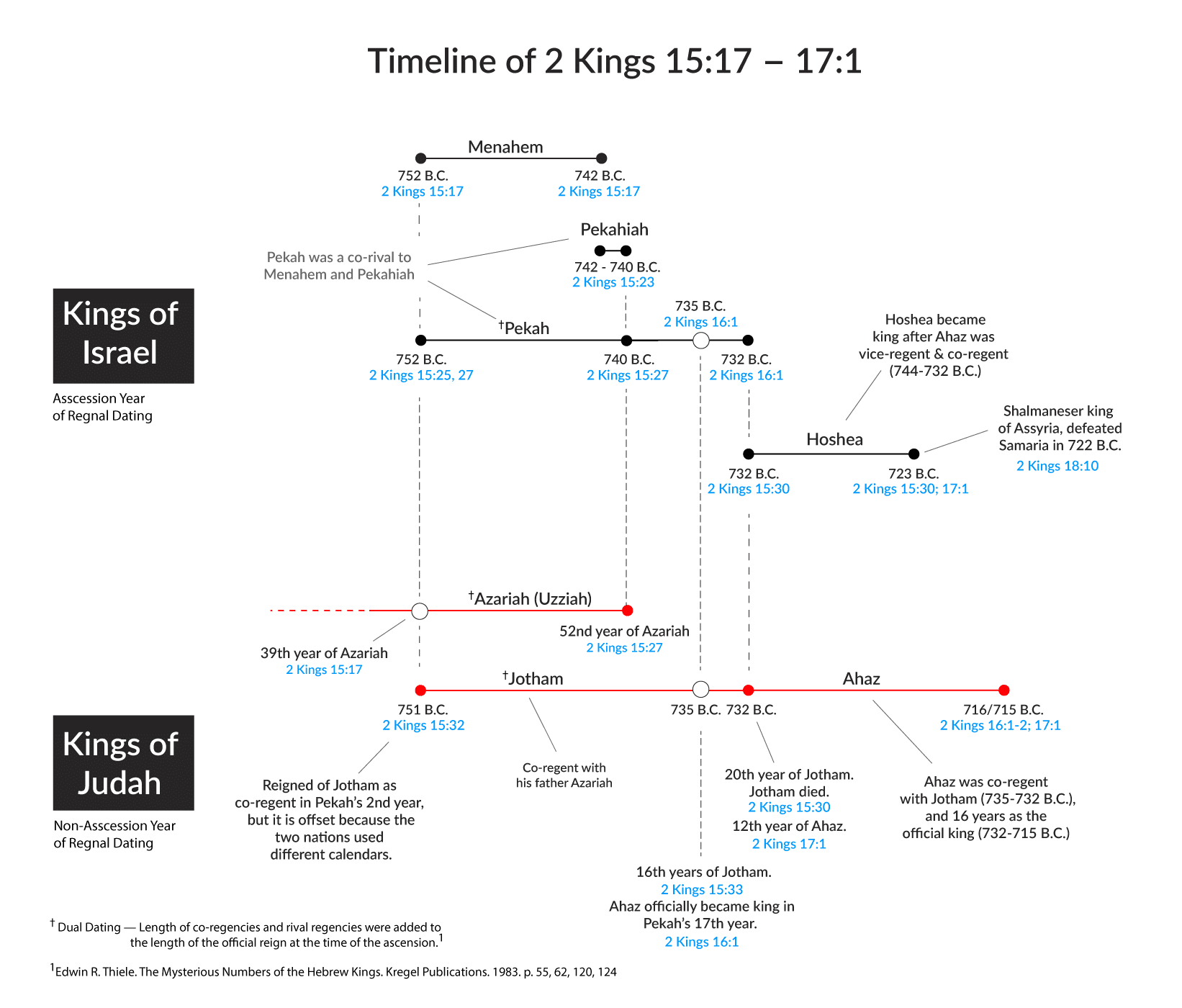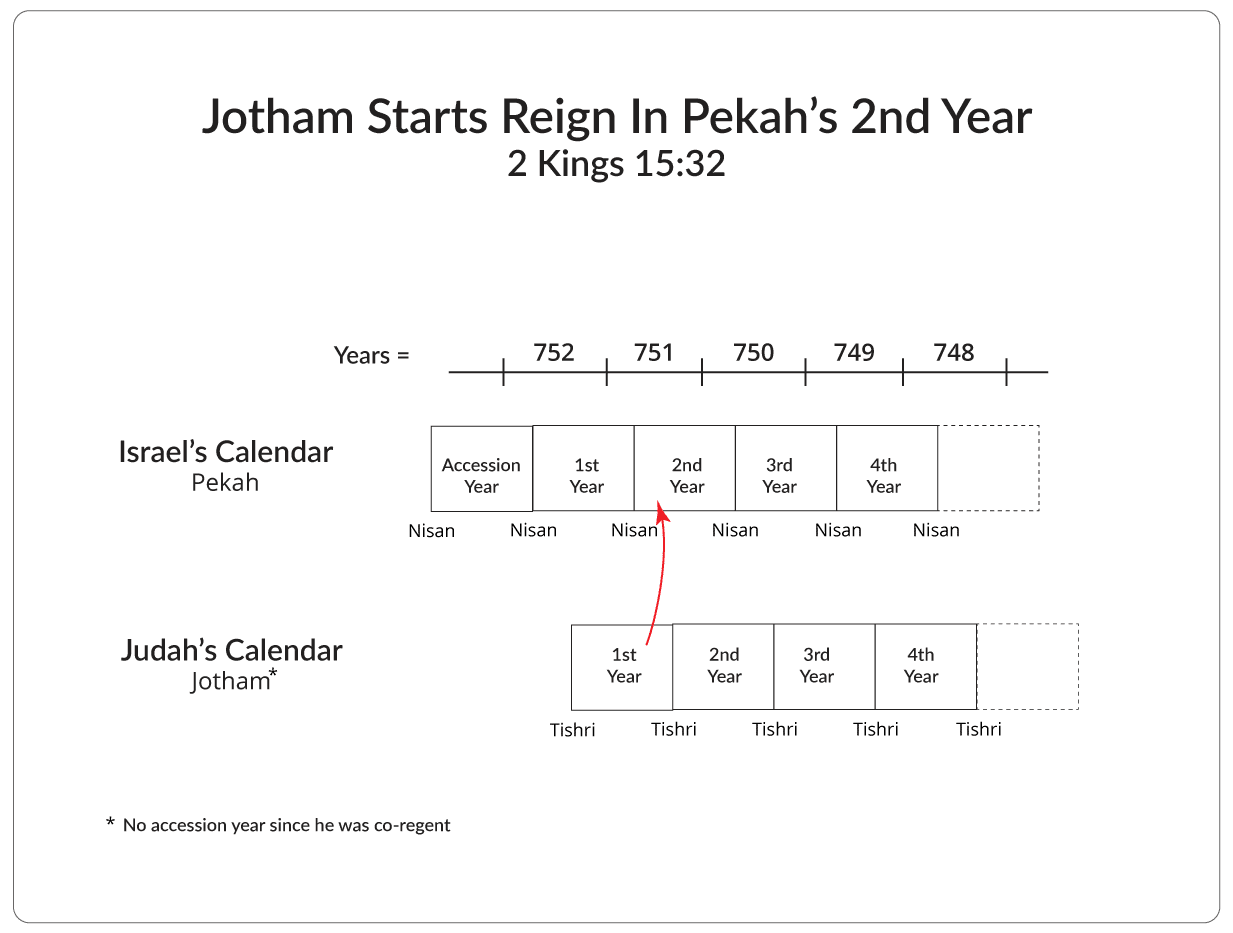Bible Question:
How can 2 Kings 17:1 and 15:30 be reconciled while still holding to an Assyrian captivity of 723/722 BC? Please consider 2 Kings 16:1 and 18:1.
Bible Answer:
A casual comparison of the timelines of the reigns of Azariah (Uzziah), Jotham, Ahaz, Menahem, Pekahiah, Pekah, and Hoshea suggests there are serious contradictions. First, it seems the reign of Hoshea, as described in 2 Kings 15:17-17:1, does not end prior to the Assyrian invasion in 722 B.C. as it should. Instead, 2 Kings 15:17-17:1 suggests the timeline of the reigns of these kings results in Hoshea’s reign ending twelve years after 722 B.C.
Second, the dates of the reigns of Pekah and Jotham appear to be contradictory. Therefore, the purpose of this study is to answer the question, “Does the timeline of Israel’s Kings agree with Assyria’s Invasion?” The following explanation to the question is lengthy since the problem appears to be contradictory. The solution is summarized in the chart below. The chart may be downloaded.

Dual Dating of the Hebrew Kings’ Reigns
The fundamental problem with understanding the timeline of the reigns of the Hebrew kings is that a concept known as dual dating was practiced in both Israel and Judah during the events described in 2 Kings 15:17-17:1. This practice of dual dating is described by Edwin R. Thiele in his book The Mysterious Numbers of the Hebrew Kings. Dual dating occurred when the reigns of kings, co-regents or co-rivals, overlapped. The time of the overlap is added to the official reign of the king after his official accession to the throne, and reported as his full reign.[1]
Examples of dual dating occurred in the northern kingdom of Israel during the reigns of Omri and Asa (1 Kings 16:15-18, 23, 29).[2] The second example is between Jeroboam II and Jehoash (2 Kings 14:8-13, 17, 23; 15:1).[3] The third example is between Menahem, Pekahiah, and Pekah (2 Kings 15:17, 23, 27; Hosea 5:5).[4]
The first example of dual dating in the southern kingdom of Judah occurred during the reigns of Jehoshaphat and Asa (1 Kings 22:41-42.[5] The second example is Jehoram and Jehoshaphat (2 Kings 1:17; 3:1).[6] The third example is between Amaziah and Azariah (2 Kings 14:1-2, 13, 21, 23; 15:2, 8).[7] The fourth example is between Jotham and Azariah (2 Kings 15:1-5, 32).[8] The fifth example is Jotham and Ahaz (2 Kings 15:30, 33; 16:1, 5-9).[9] The sixth example was between Manasseh and Hezekiah (2 Kings 20:1-21).[10]
In these three chapters, the critical reigns are those of Menahem, Pekahiah, and Pekah in the northern kingdom, and those of Jotham and Ahaz in the southern kingdom. So, review the chart above as it displays the solution to the apparent timeline “problems” described in 2 Kings 15:30 – 17:1. Now we will explain the dual dating examples that occurred in 2 Kings 15:17-17:1 in further detail.
Dual Dating of Menahem, Pekahiah, and Pekah
The first example of dual dating in 2 Kings 15:17-17:1 is between the kings of Menahem, Pekahiah, and Pekah. We will begin with 2 Kings 15:17 which tells us that Menahem became king over Israel in the thirty-ninth year of Azariah and reigned for ten years over Israel while living in Samaria (752 B.C.). 2 Kings 15:22 adds that Pekahiah, the son of Menahem, became king over Israel after his father died. 2 Kings 15:23 says that Pekahiah became king over Israel in the fiftieth year of Azariah (742 B.C.), who was king over Judah. He reigned for two years and died (740 B.C.). So father and son reigned in the northern kingdom for twelve years (752 B.C. to 740 B.C.).
Now we consider Pekah who was a co-rival to Menahem and Pekahiah. This is consistent with Hosea 5:5 which suggests that there were two kings or nations (Israel and Ephraim) in the northern kingdom. So when 2 Kings 15:25 states that Pekah assassinated Pekahiah and reigned over Israel, we understand this occurred in 740 B.C. Then 2 Kings 15:27 says that Pekah reigned for a total of twenty years.
In the fifty-second year of Azariah king of Judah, Pekah son of Remaliah became king over Israel in Samaria, and reigned twenty years. 2 Kings 15:27 (NASB)
Now if we ignore the dual dating system, the reader will assume that the twenty years of Pekah’s reign started in 740 B.C. and ended in 720 B.C. But there is a problem with this assumption because Assyrian records tell us that Pekah’s reign ended in the year 732 B.C.[11] Apparently, the Assyrian king Tailgate-pileser III used Hoshea to kill Pekah in his twentieth year (2 Kings 15:27, 30). So, if we work backwards, that means Pekah’s reign started in 752 B.C. This reveals Pekah is an example of the dual dating system.
Remember that in the dual dating system the full length of a king’s reign was counted from the time he officially became king. The dual dating system combined the length of co-regency or co-rivalry together with the official length of Pekah’s reign for a total of twenty years. The system then reported the twenty years from the point the king started his official rule (2 Kings 15:30). His reign started on 752 B.C. and ended in 732 B.C.
The next king in the northern kingdom was Hoshea. As discussed above, 2 Kings 15:30 says he assassinated Pekah (732 B.C.) and became king in the twentieth year of Jotham. In addition, 2 Kings 17:1 says he became king in the twelfth year of Ahaz and reigned for 9 years (732-723 B.C.). This information is supported by Assyrian records that reveal the invasion occurred in 722 B.C. 2 Kings 17:3 says Shalmaneser, king of Assyria, defeated Hoshea. Hoshea became his servant and paid tribute (723 B.C.). 2 Kings 17:4 adds that Shalmaneser king of Assyria “shut him up” and put him in prison. Finally, we discover from 2 Kings 18:10 that Samaria was captured in the ninth year of Hoshea by Shalmaneser king of Assyria (723 B.C.). So, Hoshea reigned in Israel from 732 B.C. to 723 B.C.
So if Pekah’s official reign of twenty years did start in 740 B.C., then it would have ended in 720 B.C. That would have been too late. This further reveals the dual dating system was practiced. So, Pekah began reigning as co-rival to Menahem and Pekahiah in 752 B.C. until 740 B.C. He assassinated Pekahiah and became the official king in 740 B.C. and reigned eight more years until 732 B.C., for a total of twenty years and was killed by Hoshea.
Dual Dating of Jotham and Ahaz
The second dual dating in 2 Kings 15:17-17:1 occurred between Jotham and Ahaz. But first it must be understood that the start of the reigns of Pekah and Jotham, the king over Judah, coincided. 2 Kings 15:32 says Jotham, the king in Judah, began to reign in the second year of Pekah. Now we must understand that the two kingdoms used two different calendars (Tishri-to-Tishri and Nisan-to-Nisan). This leads us to conclude that Jotham’s reign started in the first part of Pekah’s second year (see the chart below).[12] In addition, the dates of their reigns are offset by one calendar year due to the arrangement of their calendars. Therefore, Pekah’s reign began in 752 and Jotham’s started in 751 B.C.

Next, 2 Kings 15:17 says that Menahem became king over Israel in the thirty-ninth year of Azariah (752 B.C.). 2 Kings 15:5 says that Jotham was not officially reigning as king with Azariah but was sharing the throne since Azariah was a leper. So Jotham was a co-regent and the dual dating practice was in process.
As discussed in the previous section, Jotham’s reign started in 751 B.C. Next, 2 Kings 15:32-33 says that Jotham reigned for sixteen years (751 B.C. – 735 B.C.). He reigned as co-regent with Azariah. Next, he officially reigned as king for four more years (735 B.C. – 732 B.C.) for a total of 20 years (752 B.C. – 732 B.C.) according to the dual dating system (2 Kings 15:30). In addition, 2 Kings 16:1 says that in the seventeenth year of Pekah (735 B.C.) Ahaz officially became king.
In the seventeenth year of Pekah the son of Remaliah, Ahaz the son of Jotham, king of Judah, became king. 2 Kings 16:1 (NASB)
The seventeenth year of Pekah was 735 B.C. and 2 Kings 16:2 adds that Ahaz officially reigned for sixteen years. Therefore, this means that Ahaz was co-regent with Jotham for four years (735-732 B.C.), and then sixteen years as the official king (732-715 B.C.) for a total of twenty years, even though Jotham only officially reigned as king for four years (735 B.C. – 732 B.C.). That is the second example of the duo dating system.
Conclusion
At this point, all of the apparent contradictions and problems that we planned to address have been explained using the customs of the two kingdoms around the dates of 752 B.C. to 722 B.C. An understanding of the dual dating system, the accession-year dating, and the overlapping calendars are essential. For further information, the reader is encouraged to buy Edwin R. Thiele. The Mysterious Numbers of the Hebrew Kings. Kregel Publications. 1983.
Now does the timeline of Israel’s kings agree with Assyria’s Invasion? The answer is yes! We have discovered that the timeline given in 2 Kings 15:17-17:1 is consistent with the Assyrian invasion of 722 B.C.
This study has demonstrated once again that Scripture is without error. We have not employed any deceptive practices nor argued for a scribal error. It was not necessary since the customs of the time solves what appeared to be a contradiction. Every Christian must remember that the inspired Word of God is without error in the original autographs.
All Scripture is inspired by God and profitable for teaching, for reproof, for correction, for training in righteousness; so that the man of God may be adequate, equipped for every good work. 2 Timothy 3:16-17 (NASB)
References:
1. Edwin R. Thiele. The Mysterious Numbers of the Hebrew Kings. Kregel Publications. 1983. p. 55.
2. Ibid., p. 62.
3. Ibid., pp. 62-63.
4. Ibid., p. 63.
5. Ibid. p. 63.
6. Ibid.
7. Ibid., pp. 63-64.
8. Ibid., p. 64.
9. Ibid.
10. Ibid.
11. James Pritchard, ed., Ancient Near Eastern Texts Relating to the Old Testament. 3rd ed., Princeton, New Jersey. 1969., p. 284. quoted by Walvoord and Zuck. the Bible Knowledge Commentary. ChariotVictor Publishing. 1985 p. 568.
12. Ibid. p. 131.
Suggested Links:
Can we trust the Bible if we do not have the autographs?Why We Can Trust The Bible — Inspiration and the Canon of Scripture
Does the Bible contain errors, discrepancies, contradictions or mistakes?
How Accurate Is the Bible?